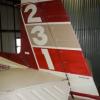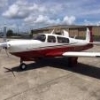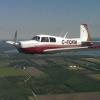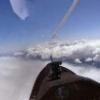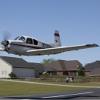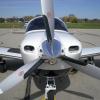Leaderboard
Popular Content
Showing content with the highest reputation on 07/04/2016 in all areas
-
I've been wanting to make a sight seeing trip to Big Bend for some time. Today was it. We landed at Presidio. A small airport that was deserted. They did however have some frozen home made burritos in the freezer that we had for lunch. Then it was off to follow the Rio Grande. --My wife was a super trooper. And after a while, she asked why I wasn't talking to anyone. About an hour with no radio chatter at all. -It's all class G out that way and there is no radio reception. I couldn't explain it beyond saying it uncontrolled airspace6 points
-
3 points
-
Late this morning the wife and I made a return trip from Lakefront-Cleveland, OH to our home base in Blackstone, VA. 1.75 vmc out of a 2 hour flight. Light to moderate rain most of the route with a nice GPS approach ending. Breaking out close to minimums with the runway exactly where it is supposed to be never gets old! Magic Carpet ride! Also, Cleveland was great. Tired of the heat and humidity we set out to find better weather. We laid out a 2.5 hour radius and Cleveland had the nicest forecast so off we went. We were airborne Saturday morning and were greeted with 70 and clear with a nice breeze. Walked all of downtown, ate some great food and enjoyed the sites. Another great weekend made possible by our Mooney.3 points
-
We hold these truths to be self evident, that all men are created equal, that they are endowed by their Creator with certain inalienable rights, that among these are Life, Liberty, and the pursuit of that Mooney in front of them which they'll never catch!3 points
-
My suggestion, just MHO, is you should fly with an instructor where you get the airplane for 1-2 hours just to make sure you've got the systems figured out and then head for home in nice weather. Flying with the previous owner could also be very helpful, if he's willing, so then you could get information about any unique quirks the airplane has and you can get model specific operating techniques. Then head for home, by yourself, in nice weather. You'll enjoy the one-on-one time with your new bird.3 points
-
Well I joined the fuel cap club. Friday I was flying to KORL when after about an hour I looked at my left wing and notice my fuel cap was not secured properly. At first I thought it is just sitting there nice and pretty why not continue. However, I knew I would be flying through some rain and possibly light turbulence closer to my destination. So I told ATC i was diverting and circled down from 110 to land at 4R9. Landed fixed the fuel cap and was on my way. So how did it happen? I got distracted fueling up at my home base when another pilot was talking to me about an unrelated airport issue.2 points
-
The Texas Wing of the Mooney Caravan was out for some Formation work this morning. 1.6 hours of chasing each other around the skies over central Texas. A great way to celebrate the 4th.2 points
-
Short of a fuel leak there is no reason to ever run out of fuel. An o360 would have to be running like crap if it were to use more than a tiny increase in fuel burn since fuel air mixture must be consistent, something the pilot would notice. My simple O360 burns a very consistent amount of fuel. For example a 7500 foot climb and an hour and fourty minute total time burned 18 gallons exactly as planned. Our 3 hour leg we go one hour back and forth always starting on the last tank used since I know it was flowing. Left right left then at my normal three hour point we were 20 minutes to home and I still had a certain one plus hour remaining on the right. I hold 27 per side and have never averaged more than 10 gph total including a long climb. Honestly if you really wanted a cheap safety fuel feature mount an automotive style backup camera under the nose facing back so you could monitor for fuel leaks as you fly.2 points
-
Summary of a PP's understanding of what he has read around here.... 1) The combination of decent FL and FF gauges affords the pilot the ability to run out of fuel with accuracy. 2) Adding digital bits and pieces allows the same pilot to run out of fuel with precision. 3) Using a high wing fuel system allows the pilot to somehow run out of fuel without anyone noticing. The challenges seem to be... 1) Plan A: It takes being aware of the situation prior to departure. Enough fuel + proper reserve. Required: calibrated and operational FL indicators, or a calibrated stick proving to the pilot he has the fuel he thinks he is starting with. Supported by: Fuel delivered quantity by the pump. 2) Plan B: It takes being aware of the situation on the fly. Fuel used or fuel remaining by the totalizer or FL gauges. Required: FF and totalizer with accuracy in the one gallon range. Supported by: FL in the one gallon range. 3) Plan C: It takes being notified of the situation before running out of physical options. Required: - operational annunciator panel that has had it's test button pressed to arm the low fuel level circuit. - know how much fuel is left when the light goes on. Some LBs had been set for 3 gallons usable per side. 15 minutes to enact the landing procedure is not very much unless you are over an airport. - in VFR conditions the lights on the anunciator panel may not be very effective without actively including them in your scan. - FL or fuel remaining (FF)connected to the GPS with an active flight plan is a great way to be given a heads up if the fuel is not enough to get to the final destination. 4) Plan D: An accurate fuel use plan compared to actual fuel used is the heads-up that is needed to keep from accidentally running out of fuel. It all starts with knowing how much fuel you are starting with. - know the fuel used in start-up, taxi, T/O, Climb, cruise, descent, landing. Climb and cruise are the most significant. Descent can be included in cruise with minimal accuracy losses on the safe side. - switch tanks according to a plan. Do you switch at the TOC, followed by every hour after that? Some people change each 10 gallons or so... Since climbing in a NA plane uses a non-consistent FF when leaning using the Taget EGT / blue box method. I burn the lesser known amount of fuel from one tank. I usually start from the left tank for consistency. - some people like to intentionally run a tank dry. This leaves the last usable fuel on one side. Without a real good FL gauge, the feeling of unease becomes stronger after one tank is empty. The ability to adjust rate of descent into a short field is impossible after the second tank runs dry. 5) Plan E: Knowing what the legal reserve looks like on the FL indicators. - know what 5, 10, 15 gallons looks like on the FL indicators. Does it even show up? Does it become unreadable in flight? 6) Plan F: Verify there are no fuel leaks or fuel use surprises. Fuel use surprise may be caused by simply not remembering to set the mixture properly. - leak after the FF meter. Check to see if FF matches the various flight segments T/O and climb FF, and cruise FF (ROP or LOP) - leak before the FF meter. Check to see if FL matches expectations each time the valve is switched. -Checking fuel used from two independent sources would be cool! CIES vs FT101... Hmmmmmmmm 7) Plan G: Commercial wide scale adoption Of CIES digital floats would be aided by word of mouth of three groups... Bonal has offered his plane as a test bed and has shown himself as an excellent member of MS. - Short body Mooneys A, B, C, D, E... (Bonal fits in this group) - Mid length body Mooneys F, G, J, K... (A group of 10 is requested for float arm development / study related to tank design) - Long Body Mooneys L, M, R, S... let me know What I missed. There has to be plenty more... Best regards, -a-2 points
-
GATEQ can only be defined by DME or IFR GPS. If you have that equipment on board and can identify the GATEQ fix you can use the lower minimums. This only applies to the MDA on the LOC or Circling approaches. The DA doesn't change for the ILS.2 points
-
Yesterday aviation activity was: Clean and regap and rotate spark plugs - They looked pretty good. Had 75 hours since the last time. Dropped the first one out of the cleaner so had to get a new one in out of the Emergency supply bag. There were only two with lead balls stuck down inside Tighten oil head drain clamps Finish the oil change - Mouse oil exhaust Check Tire pressure Inspect brake pads -2 points
-
Since you are switching from a Johnson bar to electric, one thing to remember is you have to pull the gear handle out slightly before moving it up or down. If you don't, and force it, you can break it.2 points
-
2 points
-
1. The tubes from the sump to the cylinders are the same length, the pathway from the carb through the sump is not. This can be seen here: 2. It's not actually a different jet, rather it allows more fuel through the main jet. Because of this, you can mimic turning it off by leaning to specific fuel flow. I've run O-360's up to 13+GPH at 75% power/WOT with no additional cooling effect in the hotter cylinders. This is how this was empirically tested. These experiments were first done in the Van's RV community as far as I know, and I've duplicated much of their testing in the Cardinal. 3. Yes, total fuel flow is the only really accurate way of determining what is getting in. A reality check is done with how much lead fouling is going on in the plugs as well. Exactly, the theory as to why is that the airflow pattern changes, which allows more of the atomized fuel to remain in the air streams to each cylinder. Another technique has been to add Carb Heat to Vaporize the fuel droplets, which keeps them in the air stream more linearly as well. This obviously WILL result in some power loss, but can help achieve LOP operations in SOME aircraft. What 10- Number is your carb? The testing has all be done with the 10-3878, which is the standard O-360-A1A carb. I know there is a richer one available for the M20C, but I don't know the 10- number. Either way, the AA is an altitude compensation system, not power enrichment/economizer. I'm not trying to start an argument here, this is just right down an alley I've been down before. The powerflow exhaust also helps even out the fuel distribution in Cessna's. I don't know how the Mooney exhaust is, so I don't know if it helps much there. The downside is, there is extra power available, which amounts to extra heat that needs to be dissipated.2 points
-
We can use the Mooney Caravan tent on Monday at 6 PM to do a MooneySpace get together if you guys promise to show up. Who is willing to come on Monday at 6 PM? Yves2 points
-
Congrats on the new J! If you're concerned, even in the slightest, find an instructor to ride shotgun... But... the airplanes (E vs. J) are very similar. They fly very similar (as do all mooney's), as well (same wing, same motor, same push pull rod design, etc). CG and weight are slightly different, but not appreciably. You would not be making a foolish or unsafe decision IMO by flying it solo. If it were me, I would fly it back without hesitation, solo (VFR... But not IFR until I was comfortable with the panel and had shot a couple practice approaches). some feel there is a great difference between mooney models: personally I see the greatest difference primarily between power plants and panels. So long as your power plant is the same, and you are comfortable with the panel, the mooney will fly how you'd expect: just like a mooney. while that's my opinion, we probably don't have the same background in aviation (I doubt any two mooney spacers do!): if you really are having doubts- piece of mind may be worth it to hire an instructor or bring along a pilot that has experience in a J model. Any thought to taking a test flight with the previous owner so he can show you the ropes? Just a thought. Good luck!2 points
-
14 min 17 sec to my older daughter's future college - will come in handy for weekend lunches. Comfortable co-pilot at my side. Sent from my iPad using Tapatalk2 points
-
I'll be flying in with the Mooney Caravan and camping on the North40. Just added some fresh color to the plane, and should have a new N# just in time as well.2 points
-
Don't stress it, it really isn't that bad. You show up at Ripon and follow someone in. You should be flying at 90 knots or slower on your downwind, so you already know how to do it. My plan is to drop the gear and possibly some flaps to keep it slow. Dirty up the airframe sufficiently and the Mooney will fly just like a Skyhawk. Follow the Notam and it will be just fine. i have the inverse problem from when I first flew to Oshkosh 6 months after my private check ride in my trusty Cessna 150. That aircraft struggled to make it up to 90 knots. The Mooney will have trouble going that slow. What a wonderful irony. i hope to meet everyone there. I owe beers for all the good advice and wisdom I've learned from this site.1 point
-
Precision landing is good. They tell you what color dot to land on and it is good to be as close to it as possible. One thing that stands out is the ability to know your air speed and be scanning for traffic at all times while listening to the radio. It really helps having a second pilot or knowledgable/experienced person on board. It really helps to have the procedures really well reviewed. Changes in wind and weather can change the arrival procedure. Radio traffic is at a high level,. Sort of normal for IR pilots. Additional weight on an ordinary pilot's multi-tasking ability. Practice your multitasking abilities, while flying with precision speed control. One of the challenges is there is somebody landing short on the same runway as somebody else landing long. If you are on the first dot, don't land long. If you are on the last dot, don't land early... Know the MP for your plane's weight that will keep you flying without descending once over the numbers at final approach speed in the event you need to extend the float a little and not invade an earlier dot on the ground... Have the go around procedure memorized and in mind on approach to your dot. Something may make you want to use it. You don't want to run into somebody landing in front of you. Be ready to say what you are doing clearly on the radio... Also know your stall speed vs. bank angles. There may be a point where you can't turn anymore to make the runway and dot that you have been assigned. Do not turn a communication challenge into a steep turn to final stall situation.... a pilot needs to know his limitations and how not to exceed them... PP ideas that come to mind. Not a CFI... Best regards, -a-1 point
-
100 MPH is plenty above stall speed and even 80 allows some maneuver margin. Go up to a safe altitude and practice 30 degree S turns at 80 mph.1 point
-
Your logic path not really worky "Reinforcement of checking starting fuel value (use of a stick) and planning are the two tools of preventing this incident from occurring " Not Reinforcement. This is the primary way to know if you will run out of fuel. Gauges are secondary. I fly by sound of the engine as much as by gauges. "Aircraft with a digital fuel quantity systems have to date - suffered zero fuel starvation / exhaustion events. " What percentage of the GA fleet has digital gauges? Very small so not statistically relevant statement. And I do recall several Commercial planes with "good" fuel gauges that had to do a dead stick landing due to no fuel. Wikapedia is your friend here https://en.wikipedia.org/wiki/Fuel_starvation "It may be, but not proven at this time, that quality fuel indication may be the method that allows good pilots better tools and will provide a timely warning assist those careless pilots an opportunity to correct the preflight mistakes they may have made. Most new aircraft delivered have digital fuel quantity systems, and soon nearly all new aircraft will have a digital fuel quantity systems. If the current trend of no fuel starvation with digital fuel indication continues - fuel related accidents will go down. " Fuel gauges are secondary teaching people to rely on the stick and knowing the burn and knowing how long they are in the air is the key to not having the fan quit.1 point
-
1 point
-
Well parts are ordered, and I kept the advice from this thread in mind while I did so. They should be here within the week, now just a matter of getting the mechanic on board. With luck I'll have time to run out and help/witness. I did the brake pads and wheel bearings on my old airplane, seemed way easier than doing them on my bike. Most expensive tire chnage I've ever seen, and I ran some pretty high powered tires on my Sport bike (which was way faster than any GSXR).1 point
-
I certainly don't feel like re reading this so not even sure your product is available for our Mooney's and one with bladders to boot. If your looking for a volunteer for beta testing mine would be available of course me being the CB I am and having to spend all of my available budget on things need fixing it would have to be on your dime. Im out.1 point
-
I always leave my key set in the luggage door. Without the keys it's hard to start the plane.1 point
-
Better than me asking for gas at an FBO during a trip. Fuel cap not on right. Not even close. Rain came. So did the quart of water in my tank. Found it on preflight. Spent a lot of time draining. I educated the line guys that they could have killed me no big deal or anything just don't ever let it happen again. Now all FBI fueling is supervised. Can I be in the fuel cap misadventure club?1 point
-
I'm well aware of that and I was when I made the comment. I saw that you referred to the "law of England and Wales" and that your profile says you in the UK. I even know that UK companies use the "law of England and Wales" as part of their general disclaimers for the use of their websites, much as US companies make jurisdictional statements on their websites. I used the Facebook nonsense (which also makes the rounds in the UK) as an example and my wondering continues.No one would be able to use your comments and photos as evidence in the US anyway, regardless of your notice.1 point
-
Bob, very good points but the thing is I know my gauges are lying and any device can malfunction if you have a fuel loss and your true fully accurate gauge also fails your still in the same boat. Unfortunately there is no way to guarantee a perfect solution. I would love to have an accurate system but in my case fuel gauge is like number 100 on the list and I'm on number ?1 point
-
1 point
-
Sounds like you have your priorities straight, Tom. Many people could gain real benefit in their lives from your obviously long,deep thinking in the hospital. Congratulations in reaching the point where you can now finish it up and bring her to life. Just be careful when you start flying her . . . She's a beast!1 point
-
Many avionics shops have a test set to simulate strikes- range and bearing. A "poor mans" test set can be a better you powered or electric drill held near the stormscope antenna. Should light it up pretty good. A properly installed detector should do a firmly reasonable job of keeping you out of storms. It is still more of a strategic device, but unlike datalink weather it is real time. It is also a good predictive device. It will (should) show a building T storm before your radar can detect it, it is thus complimentary to the radar in the Hawker. They are not perfect in range and bearing, but are better than nothing and certainly not obsolete, even with datalink. Goodrich used to put out a really good pilots guide on interpreting the stormscope. Worth the read if using one and generally applies to all spherics devices.1 point
-
Welcome! I was based at fox up until this past November. I actually grew up in that area. I'm based at corona KAJO now. I remember when that airplane arrived at WJF. I think he bounded it pretty bad (proposed) and hit the prop. It sat in the same spot for a very long time. Glad it's getting some love. You and I are close in age. Not very many youngsters flying let alone owning. Mooneyspace is great! All the guys on here have so much experience with mooneys! Can't wait to see what you do. If you need a panel I just had mine done and the guy I got it from has the file for the CAD. LMK. Good luck! Mike1 point
-
What you need is "differences" training, not transition. The a/c is similar enought that your knowledge will transfer to flying he machine. What you need help with is all the differences. Starting from normals to non-normal procedures. Review the POH, make sure you are comfortable with all the procedures, and with non-normal stuff like glide speed, emergency gear extension, electrical problems, what do the annunciator lights mean? Etc. you definitely need help with that, someone who is familiar with that plane should share that with you. You will be better prepared to fly it home if you are comfortable to deal w all those contingencies. Remember a plane doesn't care it's you first hour in it, if something weird happens you want to have already thought about it at least...1 point
-
I bought a the big tank (150 cf) above from AirGas for $229.60. The CGA540 to CGA 540 transfill adapter cost $95 from Branton Veterinary Anesthesia Supply. Refills (exchange) cost $22. for 150 cf @ 2200 psi My on board tank is 24 cf so I can keep it near full pressure for a very long time. (I share with a couple of J owners on the field who are like I am, occasional users) No rent, not concern for tank certification which on AirGas If I were using more O2 I'd get a second tank to be able to cascade but not worth it when the big tank ($22) lasts more than a year easy peesy1 point
-
right click on the image file, from the pop up menu select "send to" in the expanded menu select "mail recipient" the attach files window opens allowing you to resize the file (I usually choose medium) The image will be added to the attachment line on your email window. Simply copy and paste that file into an appropriate folder and it will automatically be sized for almost any webpage.1 point
-
My two cents - I think you're being a bit too cautious. Powerplants are similar and if anything the panel is easier to configure with electric gear/flaps/ Etc. However if you were moving from a C to and R or other long body/ larger power plant, it would be wise to bring a companion.1 point
-
This is great! I'll be there from the 28-31 but will be coming in my friends Baron. Can't wait to see all the mooneys; my first time at osh kosh. Safe travels all.1 point
-
Hate to one up you but I stopped at an airport in Kansas that had a legal pad and a coffee can with about $500 in cash in it. It said to write down how much gas you took and put the money in the can.1 point
-
So I talked to LASAR. 1. The STC is available and covers all Lycoming IO-360-xxx models. 2. Lot's of other stuff has to be replaced including cowl, engine controls, motor mount, engine instruments, etc. 3. He said according to Lycoming the O360 actually produces about 184 HP and the IO360 only produces about 195HP. 4. After describing the frustration with my C, it was suggested to get the carburetor checked, serviced, overhauled. (Pretty much what all of you said) It's been said before, but there's a heap of good expertise on this forum. Thanks!1 point
-
The first thing I would do if I were you, is get my aircraft on a winter cycle for annual. Around here, it is tough to fly in the winter anyway, and I don't want the plane in the shop when the flying weather is good, too depressing. It is weird. I can not fly the plane for ten days or two weeks and it doesn't bother me in the least, but if I can't fly it because it is in the shop for that length of time, I get depressed.1 point
-
No matter what actually happened, or why, inexperience probably played a factor. I feel that way even more after listening to the ATC recording. The real lesson here for all of us (and maybe a little more for our less experienced friends who are still working toward the PPL) is that we all have to continue to learn and get better. As Mooneymite's avatar says: Perpetual Student (even though he has 20,000+ hours). The Private license isn't an end, it's a beginning. It is a license to learn. It's late, I'll get off my soapbox to get a beer.1 point
-
Use plain English and tell them what you need or want. The tower controller saw her go down, he doesn't want to have to live with that. I'm a controller myself, and I actually spoke to that exact airplane earlier today. She transitioned through my airspace. She sounded unsure over the radio the whole time. If you cannot except a runway due to winds, you need to say something. It is your life on the line. Not all controllers are pilots. And at an airport like Houston hobby, they're used to talking to professional pilots, who have tons of experience and can typically do whatever you need them to do. The controller wasn't asking too much of her. Anyways, if you as the pilot feels uncomfortable at any point in time, you need to say something. Unfortunately it came down to an uncoordinated turn at slow speeds resulting in a flat spin.1 point
-
None whatsoever. It's a pretty easy job assuming you know how you operate a screwdriver.1 point
-
Unicom, I am probably one of the few people who have owned both, the original Whelen PAR46 Parmetheus as well as the newer updated Parmetheus Plus. I bought my original Parmetheus in late 2012 and flew a couple hundred hours with it never turning it off except for start ups and shut downs. It definitely helps with being visible to other aircraft even during the day and I think LED lights are much more visible during the day time than incandescents. When I heard Whelen came out with a brighter Parmetheus I was intrigued. I fly a lot at night so much runway illumination is important to me. I read and was told that the new light was about 40% brighter than the original. I decided to try it and picked one up for cheap at Airvemture last year. Using a 12V power supply I did a side by side comparison in my hangar with the original Parmetheus mounted on my plane and the new Plus right out of the box. The Plus is definitely brighter but the beam also seemed a little narrower and I remember wondering if maybe Whelen didn't just focus the light a little tighter. Later, I installed and flew the Plus. I can say it was noticeably brighter than the original but not by leaps and bounds. I'd say 40% is an honest and accurate improvement in brightness from my experience. I'm glad I made the switch. I sold my old Parmetheus to offset the cost of buying the Plus. If you're upgrading to the Parmetheus from an incandescent I'd say spend the extra money and get the Plus. If you're an original Parmetheus owner and asking about upgrading I would say, only if you fly a lot at night and brightness is really that important to you. Otherwise I'd say, save your money. I hope this helps. Steve1 point

